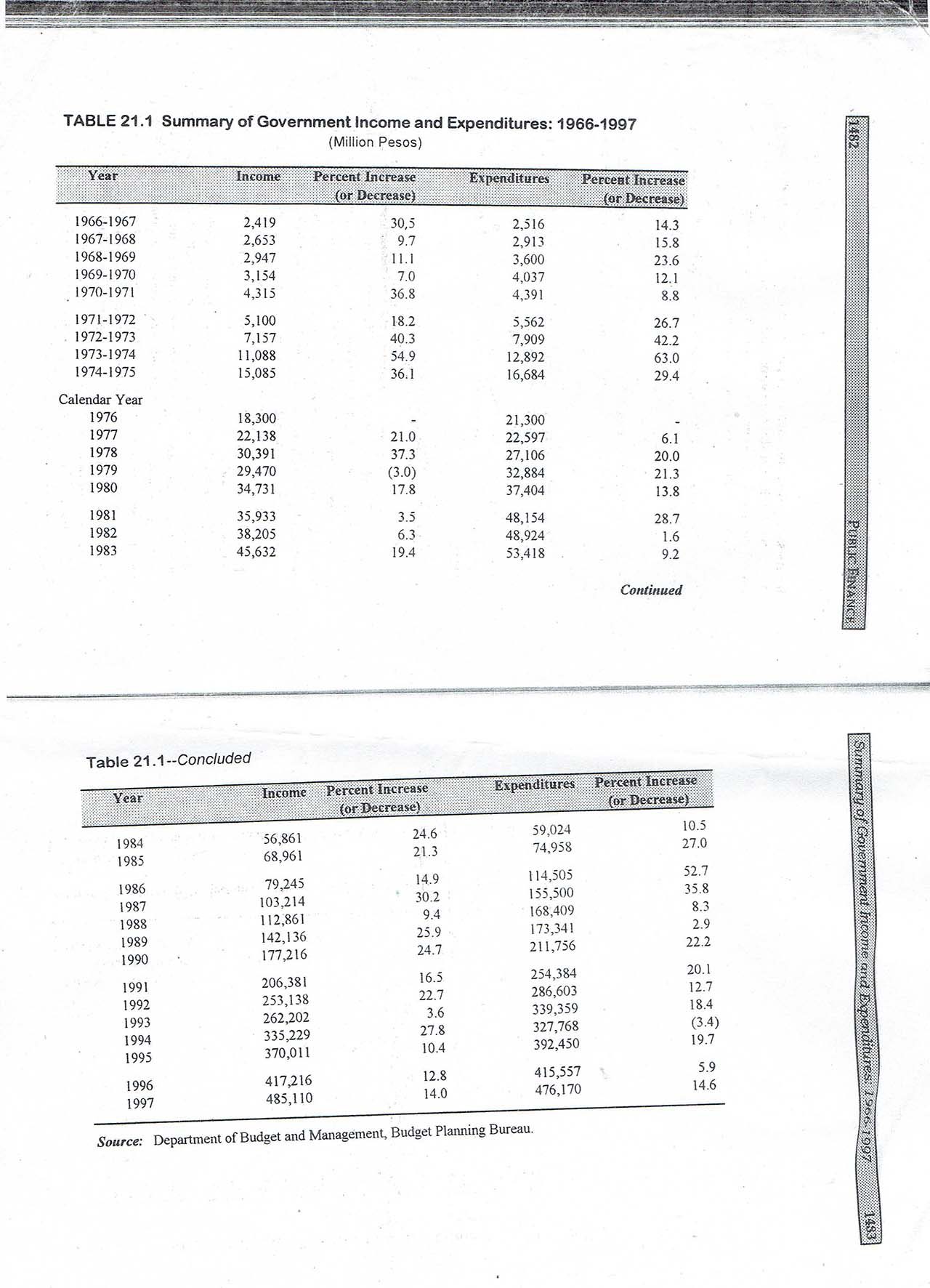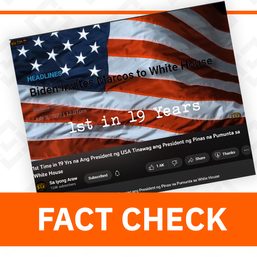SUMMARY
This is AI generated summarization, which may have errors. For context, always refer to the full article.

Claim: Data from the 1997 Philippine Yearbook released by the National Statistics Office (NSO) shows a summary of government expenditures under former presidents Ferdinand E. Marcos, Corazon Aquino, and Fidel Ramos.
Rating: FALSE
Why we fact-checked this: The false claim can be found in a screenshot from a Twitter post on June 13, 2023, with 339 views. The Twitter account no longer exists as of writing.
The following can also be seen in the screenshot: “President Marcos built a massive infrastructure program and had other achievements while succeeding presidents had little to show despite their huge budgets.”
The same screenshot has been spreading as early as 2019; Rappler published a fact-check of the false claim on April 8, 2019. In that article, the source of the screenshot was a Facebook post by Larry Gadon, who was a senatorial candidate in the 2016, 2019, and 2022 elections. Gadon is also a lawyer who has been suspended by the Supreme Court at least twice for unbecoming behavior and languge.

The facts: The figures cited in the screenshot are incorrect and misleading. The NSO, now the Philippine Statistics Authority (PSA), releases annual expenditures, not summaries of government spending by presidency. It is also misleading to compare the peso values without adjusting for inflation.
Information from the PSA: The April 2019 Rappler fact-check cited information published by the PSA on government income and expenditures from 1966 to 1997. The figures are shown in millions, contradicting the erroneously-inflated figures shown in the screenshot.

The same information above can also be found in two resources published by the PSA and available online: (1) the 1994 Philippine Yearbook’s “Table 21.1 Summary of Government Income and Expenditures: 1964-1994,” which shows government expenditures from 1966 to 1993:

(2) the 1997 Philippine Statistical Yearbook’s Table 15.4, which shows government expenditures from 1994 to 1997. There are some inconsistencies in the figures prior to 1994 here compared to the figures in the Philippine Yearbook. (The Philippine Yearbook and the Philippine Statistical Yearbook are different publications.)


In both sources, the figures are expressed in millions.
Adding up these figures would lead to the same results cited in Rappler’s previous fact-check:
| Years | Expenditures (in million pesos) |
| 1966-1986 (Marcos) | 600,778 |
| 1986-1992 (Aquino) | 1,364,498 |
| 1992-1997 (Ramos) | 2,237,907 |
A note on the numbers:
- 600,778 million pesos is 600,778 × 1,000,000 = 600,778,000,000 or P600.778 billion
- 1,364,498 million pesos is 1,364,498 × 1,000,000 = 1,364,498,000,000, or around P1.364 trillion
- 2,237,907 million pesos is 2,237,907 × 1,000,000 = 2,237,907,000,000, or around P2.238 trillion
Inflated figures: The numbers in the screenshot incorrectly used commas and decimal places, resulting in outrageously large figures.
Adjusting decimal places, Marcos’ supposed spending of “P486,273 billion” would translate to P486 trillion.
Meanwhile, Aquino’s “P1,077,895 T (trillion)” expenditures would inflate the number to P1.077 quintillion, and Ramos’ “P2,237,907 T” spending would be 2.238 quintillion.
Here is a summary of the large numbers involved:
| Name | Number |
| 1 million | 1,000,000 |
| 1 billion | 1,000,000,000 |
| 1 trillion | 1,000,000,000,000 |
| 1 quadrillion | 1,000,000,000,000,000 |
| 1 quintillion | 1,000,000,000,000,000,000 |
Other inaccuracies in the screenshot: It is inaccurate to state the years 1986-1991 and 1992-1997 for the Aquino and Ramos administrations, respectively, as was done in the screenshot. Aquino’s term ended on June 30, 1992, and Ramos on June 30, 1998.
Therefore, in adding government expenditures, figures for 1998 would still have to be included for Ramos, but the 1997 Philippine Yearbook would be inadequate as a source as it does not have the 1998 expenditures.
Also, the years mentioned in the screenshot do not properly correspond to the time periods covered by each administration as far as adding up budgets is concerned. For instance, 1986 covers both the Marcos and Aquino administrations, as Aquino took office in February 1986; 1992 covers both Aquino and Ramos. Additionally, almost the entirety of 1965 was under the administration of former president Diosdado Macapagal, as Marcos’s term only began on December 30, 1965.
As pointed out in Rappler’s previous fact-check: “To begin with, the NSO does not summarize government spending by presidency. What it publishes are annual expenditures.”
Comparability of pesos over time: The government expenditures in the various sources published by the PSA are nominal values, which are not adjusted for inflation. Without adjusting for inflation, it would be misleading to compare nominal values as the value of past pesos changes over time. – Percival Bueser/ Rappler.com
Percival Bueser is a graduate of Rappler’s fact-checking mentorship program. This fact check was reviewed by a member of Rappler’s research team and a senior editor. Learn more about Rappler’s fact-checking mentorship program here.
Keep us aware of suspicious Facebook pages, groups, accounts, websites, articles, or photos in your network by contacting us at factcheck@rappler.com. You may also report dubious claims to #FactsFirstPH tipline by messaging Rappler on Facebook or Newsbreak via Twitter direct message. You may also report through our Viber fact check chatbot. Let us battle disinformation one fact check at a time.
Add a comment
How does this make you feel?



![[Newspoint] The challenge of unsavory company](https://www.rappler.com/tachyon/2024/02/tl-unsavory-company.jpg?resize=257%2C257&crop=238px%2C0px%2C720px%2C720px)

![[Closer Look] ‘Join Marcos, avert Duterte’ and the danger of expediency](https://www.rappler.com/tachyon/2024/06/TL-trillanes-duterte-expediency-june-29-2024.jpg?resize=257%2C257&crop_strategy=attention)
![[Newspoint] A Freedom Week joke](https://www.rappler.com/tachyon/2024/06/20240614-Filipino-Week-joke-1.jpg?resize=257%2C257&crop_strategy=attention)




![[EDITORIAL] EDSA or no EDSA, padayon](https://www.rappler.com/tachyon/2023/02/animated-EDSA-panatang-makabayan-carousel.jpg?resize=257%2C257&crop=90px%2C0px%2C720px%2C720px)








![[EDITORIAL] Marcos, bakit mo kasama ang buong barangay sa Davos?](https://www.rappler.com/tachyon/2023/01/animated-marcos-davos-world-economic-forum-carousel.jpg?resize=257%2C257&crop_strategy=attention)

There are no comments yet. Add your comment to start the conversation.